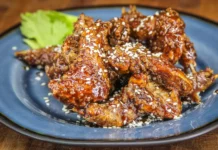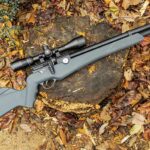The outbreak of the American Civil War provided a rare opportunity for all manner of weapons inventors and arms manufacturers to profit by offering their products to the war departments of either the Union or the Confederacy, as both scrambled to arm their troops. Some designs were unusual, but few were as bizarre as the one contributed to the Confederate cause by Jean Alexandre François Le Mat, a Paris-born aristocrat who designed firearms in his spare time.
A Creole physician (perhaps self-proclaimed), Dr. Le Mat served for a time on the staff of the governor of Louisiana. While in government service, he was awarded the military rank of colonel, a title that he was to use to his advantage in later life. On October 21, 1856, at the age of 32, he was granted United States Patent No. 15,925 for a unique percussion-pistol design in which the arbor pin of the revolver (the axis upon which the cylinder revolves) came in the form of a large smoothbore barrel, which fired a charge of grapeshot. British patents for the same design were issued in 1859. That design represented one of the first multishot percussion revolvers in a world where many people were still using flintlocks and single-shot percussion guns.
In partnership with fellow Louisianan Pierre Gustave Toutant Beauregard, a colonel in the U.S. Army, Le Mat tried to interest the Army in his revolutionary design several times in the late 1850s. While the officers who tested the prototypes were impressed, the Ordnance Department failed to express any interest.
Basically, Le Mat’s novel method involved mounting the ball-firing percussion cylinder upon a large gauge, smoothbore shotgun barrel. The nine-chambered cylinder accepted .40- to .42-caliber percussion cartridges. The grapeshot barrel was .60 to .63 caliber, or approximately 18 gauge, and received a charge of 11 buckshot. A quick flick of a small lever mounted on the hammer nose allowed the user to select the desired barrel. As the design stood, Le Mat intended to use a sliding rammer for loading the cylinder and a jointed one for loading the grapeshot barrel; when the guns were actually produced, however, a jointed rammer was employed for both duties. In addition, a removable ramrod for use in charging the shot barrel was inserted in the rammer’s lever.
The revolver was constructed of blued steel, with grips of polished walnut, and was a total of 13.25 inches long. The upper, rifled barrel was 6.75 inches long; most were octagonal in cross section, though some were round. The lower barrel was 5 inches long, and an extension could be attached to it to form a true shotgun. It was designed as a single-action weapon, equipped with a mainspring mount and hammer linkage. Shell casings were removed with a slide rod ejector.
Very few of these grapeshot pistols were manufactured prior to the outbreak of hostilities between North and South, and those produced were little more than experimental prototypes. The Le Mat pistol did not come into its own until early 1861, when Dr. Le Mat, a longtime Southern sympathizer, offered his invention to the newly formed Confederate government. At General P.G.T. Beauregard’s recommendation, the Confederate Ordnance Department offered Le Mat a contract to purchase 5,000 of his pistols.
After dropping the ‘Doctor’ from his title and adopting the more militaristic title of colonel, he first undertook a lengthy search within the Confederacy for a manufacturer with adequate facilities to produce his revolvers. Unfortunately, he was hard-pressed to locate anyone in the South who could meet his exacting standards. Negotiations with Cook and Bros. of New Orleans-his one acceptable choice-fell through. Disheartened by that failure, he traveled to France, the country of his birth, in hopes of having the weapon manufactured there.
An unfortunate choice of transportation nearly spelled the end of Colonel Le Mat’s career as an arms manufacturer. Expecting to reach France via London, he booked passage on the British mail packet Trent in the company of Confederate officials James Murray Mason and John Slidell, who were traveling to Europe in an attempt to garner aid and recognition for the fledgling Confederacy. Shortly after the beginning of the voyage, on November 8, 1861, Trent was stopped and boarded by the Federal warship San Jacinto. Both Mason and Slidell were taken into custody and interned at Fort Warren in Boston, where they remained until New Year’s Day of the following year. Despite his Confederate ties, Le Mat was not detained.
Upon reaching France at last, Le Mat eventually made an arrangement with arms manufacturers Charles Frederic Girard and Son, of 9 Passage Joinville, Paris, to produce his revolver. Their first crop of grapeshot revolvers, however, were so abysmally made that Girard and Le Mat were forced to relocate their operations to a more suitable manufacturer: the Birmingham Small Arms Company in England. Those pistols met with Le Mat’s and Girard’s satisfaction. Shipments of the guns were handed over to Confederate officials in Britain and France, who then had them slipped through the Union naval blockade that barricaded the Confederate coasts.
Originally, all Le Mat revolvers came in one model -.40 caliber above 18 gauge. That changed when purchasers for the Confederate Navy, intrigued by the Le Mat pistols manufactured for the Rebel Army, negotiated a contract with the French arms dealers for a lighter .35-caliber pistol equipped with a 28-gauge (.50 caliber) shotgun barrel. Only a few of the latter variety were manufactured, however, before the Navy canceled the contract. The Army version was used until the end of the war.
Although the Le Mat design was sturdy and reliable, it nevertheless had its flaws. The pistol was ungainly and not particularly elegant to look at; and its very unorthodoxy made it a difficult firearm to manufacture, as its abominable execution by the original French manufacturer vividly illustrated. More damning was the fact that the Amy version could not accept the regulation .44-caliber percussion (and later centerfire) cartridge that was the standard for Confederate handguns. That limited its utility a great deal, although many had been converted to the proper caliber by 1865. All told, nearly 3,000 of Le Mat’s grapeshot revolvers reached the Confederacy; its users included General Beauregard, Maj. Gens. Richard H. Anderson and J.E.B. Stuart, and Colonel George S. Patton. The great majority of the Le Mat pistols were of the percussion variety, though by the end of the war a very few centerfire Le Mats had reached the battlefield.
Le Mat’s profitable partnerships with Girard and Son and Beauregard dissolved with the Confederacy, but the good doctor elected to continue manufacturing his weapons. He produced a number of grapeshot-revolver combination guns, including a cumbersome carbine with a revolving cylinder, which was eventually used in the U.S. Army. Postwar Le Mats were equipped to take the new self-contained pinfire or centerfire metallic cartridges that had become standard toward the end of the Civil War. Manufactured primarily in Belgium and Britain, they were widely used in French penal colonies.
Le Mat’s guns continued to be popular until the late 1870s, when they suddenly and unexpectedly went out of fashion. Le Mat died shortly afterward, in 1883.
Even though they were largely supplanted after the Civil War by plainer and less ponderous pistols, Le Mat firearms were brought west in those postwar years and played a small part in the taming of the Western frontier. Ultimately, however, when revolver manufacture standardized along the lines of the simpler six-shooter as pioneered by Samuel Colt and others, the Le Mat design was put aside for posterity to wonder at, along with the pepperbox, blunderbuss and hand cannon. Time had passed it by.
This article was written by Floyd Largen and originally published in the October 1996 Military History magazine. For more great articles be sure to subscribe to Military History magazine today!















































